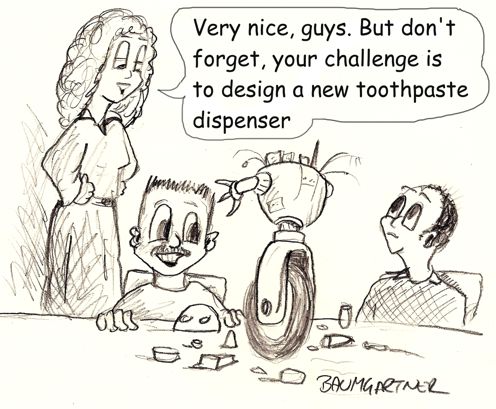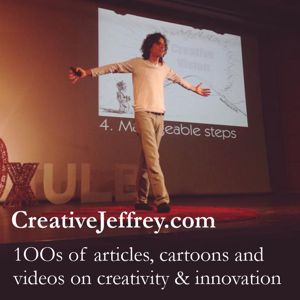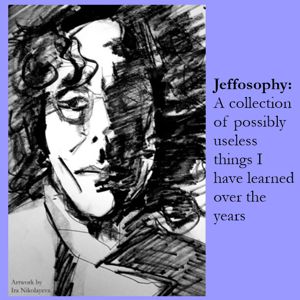Idealess Ideation
Most business and institutional ideation activities, such as brainstorming, ideas campaigns, suggestion schemes and just about everything else, focus on delivering a list of ideas. That, of course, is why it is called "ideation". In fact, business innovation has become so fixated on ideas (I call this the Cult of Ideas), there is a belief that a long list of ideas is indicative of innovation. Not only is this not true, but focusing on creating a list of ideas can actually hinder innovation!
There are three major problems with lists of ideas.
-
Poor quality of ideas. Although I have never seen any research on this, when I talk to innovation managers, they tend to agree that brainstorms and similar activities tend to generate a lot of buzzword ideas. Buzzwords are popular words that tend to be repeated endlessly in a corporate culture, but tend to have little real meaning. Meaningless ideas that sound good might please managers -- but they do not lead to innovation.
-
Tendency to choose mediocre ideas. Moreover, and research has demonstrated this, when managers are given a list of ideas from which they are expected to choose ideas to develop, they tend to choose incremental improvement ideas over highly creative ideas. So, even if an event results in one or more really creative ideas, those ideas will almost certainly be rejected in favour of less creative ideas later.
-
Creative people don't do it this way. If you look at collaborative teams in the arts and sciences, you will see that this is not how they work. They do not build lists of ideas and then vote for a best idea. Rather, they play with ideas -- trying them out one at a time and rejecting those that do not work. Once they have a good idea, they develop it into something more: an opera, a song, a film script.
So, what are the alternatives to lists of ideas? I suggest three
here. If you are creative, I expect you can come up dream up some alternatives
to lists of ideas yourself. (Please
let me know if you do!)
Build a Model
A great way to collaborate on a creative vision is to build a
model of that vision. Put a group together and give them some suitable construction
material. This could be a pile of arts and crafts supplies like paper, styrofoam,
cardboard, pens, scissors and such things; a huge box of Lego or building blocks;
or several kilos of modelling clay. Simply tell the team to build a model rather
than suggest ideas. I have had impressive results with this approach (also called
visual
brainstorming). At the end of the session, the participants will have a
nifty model to present. This approach is particularly effective if you have
a team in which some members are less than fluent with the shared language.
They might be slow to share ideas in a brainstorm, but they can build bits and
pieces for the model.
Create a Story
A great way to combine and present ideas is to put them into a story. For example: The Kwerps software company specialises in customer relationship management (CRM) software and have decided to build a module for managing social media marketing. Rather than brainstorming a list of features, the team collaborates on a story about a medium sized, traditional family run firm that finds its market share is shrinking. The firm invests in this new module and, thanks to an effective social media marketing campaign, not only regains market share, but increases it substantially. The story describes the firm, the challenges it faces, the adoption of the software, initial challenges and eventual success. Within the story is not only a description of the new software module, but a description of how a client might use it -- giving the design team insights they might not gain through listing ideas.
For even better results, this CRM company should have three small teams work on stories, each team creating a story about a different kind of client company. The stories can be compared and discussed. This would provide even more information for the programming team.
The advantage to the story telling approach is that enables the participants to see the situation in more depth, think more deeply about context and fit ideas into a more sophisticated solution.
Role Play
Role play is similar to story telling, but instead of a narrative, it results in a dialogue and a rough script. Obviously, it is useful for developing creative visions that involve interaction between people. For instance, if you want to improve how your service team performs a task, design and experiment role plays of them performing that task in different situations.
Looking again to the Kwerps software company for an example, we see that they want to improve their main CRM software product. The innovation manager puts together a team comprising product managers, software engineers and helpdesk people. In an unscripted role play, the helpdesk people play the role of the customer and some of the others play the role of helpdesk people. The group playing the customers call the group playing the helpdesk people to ask for help, seek advice and complain. Because the group playing the customers is really from the helpdesk, they can base their role play phone calls on calls they have really received.
A Single Vision of Many Ideas
As you will no doubt have noticed, although all of these approaches result in a single presentation of a creative vision, those presentations are rich in ideas and creative thinking. In a sense, idealess ideation is not so much a matter of not having ideas as fitting lots of ideas into a single vision. This has several advantages.
-
If you only have a single vision, in the form of a model, a story or a role-play, you do not have to choose from a list of ideas. There is only one choice!
-
A model, a story or a role-play is easy to present to others, such as senior managers, clients or other stake-holders.
-
A single vision makes it difficult to include empty suggestions such as buzz-word ideas that have no meaning. In a single vision, everything has to be relevant and serve a purpose. Nevertheless, you can appease the buzzword fans by including their words as adjectives in your story, model description or role-play.
- A single vision is ready for action. You can put people to work on implementing it immediately.
Doing It
Idealess ideation is so effective, I have made it a part of the anticonventional thinking (ACT) process. And, indeed, if you wish to try it out, you will need to make a number of changes from the typical ideation approach. Specifically, you need to define a call to action, rather than a problem statement; you will need to allow team members to discuss, debate, criticise and reject ideas as they build their presentation; you may find that they really enjoy this approach because the results are much more concrete than is a list of ideas.
Want Idealess Help?
If you would like to enjoy the innovative benefits of idealess innovation and ACT, get in touch! I would be happy to help. You can reply to this eJournal or contact me here.





